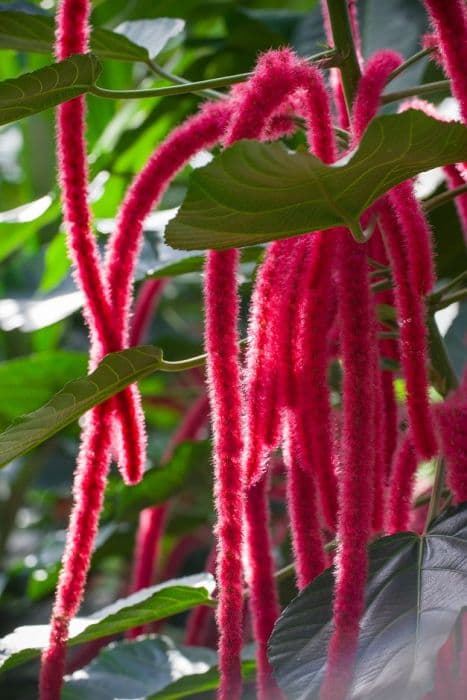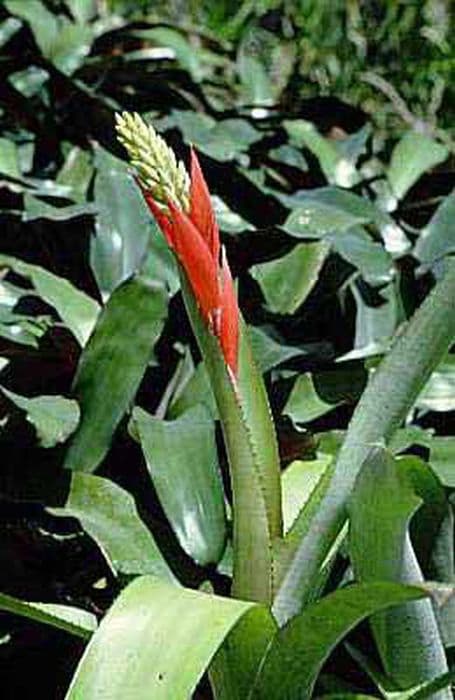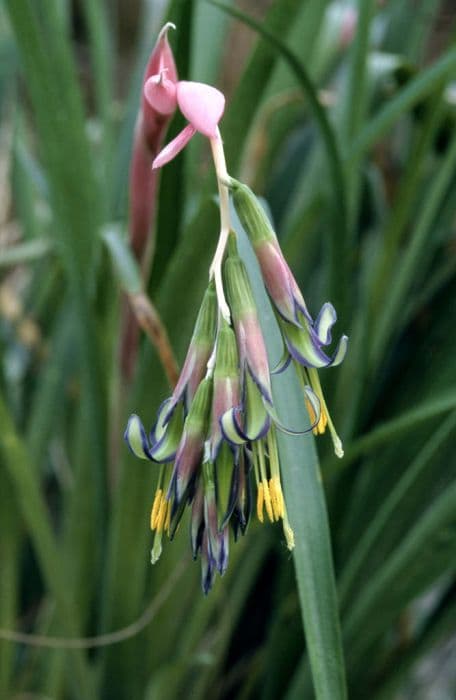Windii's Billbergia Billbergia × windii

ABOUT
Billbergia × windii, widely known as the "windii," is a striking ornamental plant. It boasts a rosette of slender, long, and arching leaves that are typically green with a glossy sheen. The foliage often displays subtle variegation or speckling. The edges of the leaves are usually saw-toothed, which adds to the plant's dramatic texture. The windii is best known for its spectacular flower spikes. The blossoms are arranged in a drooping, cluster-like manner and may feature vibrant colors such as pink, red, purple, or blue. These colors are often complemented by striking bracts that can be just as colorful as the flowers themselves, if not more so. The bracts are modified leaves that serve to attract pollinators and support the flowers. Its bloom carries a sense of the exotic, with a slightly ruffled appearance and sometimes intricate petal patterns. After the flowering period, the plant may also produce seed capsules or berries, which can add further interest to the plant's appearance. Overall, the windii's elegance and tropical flair make it an attractive addition to plant collections and indoor or outdoor display areas where a touch of the tropics is desired.
About this plant
 Names
NamesFamily
Bromeliaceae.
Synonyms
No common names available.
Common names
Billbergia × windii
 Toxicity
ToxicityTo humans
Billbergia × windii, commonly known as Queen’s-Tears, is not known to be toxic to humans. If ingested, it should not cause any significant symptoms of poisoning. However, as with any non-food plant, individual allergic reactions may occur, and it is generally advised not to consume parts of ornamental plants.
To pets
Queen’s-Tears is not known to be toxic to pets. It is considered non-toxic to cats, dogs, and horses, and therefore ingestion of this plant should not result in any significant symptoms of poisoning in pets. However, as with any plant, consumption of large quantities may lead to gastrointestinal discomfort or upset due to the unusual material in the animal's digestive tract.
 Characteristics
CharacteristicsLife cycle
Perennials
Foliage type
Evergreen
Color of leaves
Varies
Flower color
Varies
Height
1-2 feet (30-60 cm)
Spread
1-2 feet (30-60 cm)
Plant type
Herb
Hardiness zones
9
Native area
South America
Benefits
 General Benefits
General Benefits- Ease of Care: Billbergia × windii is a hardy plant that requires minimal maintenance, making it ideal for busy plant owners or those new to gardening.
- Aesthetic Appeal: With its vibrant flowers and distinctive foliage, Billbergia × windii adds a splash of color and exotic beauty to any home or garden.
- Habitat Enrichment: When planted outdoors, it provides natural habitat and food for local wildlife, including hummingbirds and butterflies.
- Drought Tolerance: This bromeliad is adapted to survive dry conditions, reducing the need for frequent watering.
- Versatility: It can be grown both indoors and outdoors, in pots or mounted on trees, making it a versatile choice for various gardening projects.
 Medical Properties
Medical PropertiesThis plant is not used for medical purposes.
 Air-purifying Qualities
Air-purifying QualitiesThis plant is not specifically known for air purifying qualities.
 Other Uses
Other Uses- Billbergia × windii can serve as a unique addition to themed gardens, especially those seeking to mimic tropical or exotic environments due to its vibrant and unusual appearance.
- The plant can be used in terrariums or bottle gardens because of its moderate size and the fact that it can thrive in the humid, enclosed conditions these environments provide.
- It's suitable for hanging baskets, where its colorful, pendulous inflorescences can be displayed attractively as they cascade over the sides.
- The long-lasting flowers of Billbergia × windii are sometimes used in cut flower arrangements, adding an exotic touch to bouquets.
- Its rosette-forming growth habit and ability to collect water in its central cup allows it to be used as a natural habitat for small aquatic organisms or insects when grown outdoors.
- Billbergia × windii can be incorporated into educational programs at schools or botanical gardens to teach about bromeliad biology and their unique epiphytic growing habits.
- This plant can be used as a living gift or party favor for events like weddings or garden parties, especially when potted in decorative containers.
- They can be used in bromeliad "trees" or as an epiphytic display on wood or bark, showcasing their ability to grow without soil.
- Billbergia × windii may be used in art and photography due to its striking form and vibrant colors, serving as an excellent subject for still life compositions or macro photography.
- As part of a green roof planting scheme, it can add variety and visual interest due to its unique flowering and foliage characteristics.
Interesting Facts
 Feng Shui
Feng ShuiThe Queen's Tears is not used in Feng Shui practice.
 Zodiac Sign Compitability
Zodiac Sign CompitabilityThe Queen's Tears is not used in astrology practice.
 Plant Symbolism
Plant Symbolism- Friendship: Billbergia × windii, commonly known as Queen's-Tears, is often associated with friendship due to its tendency to produce offsets or "pups," which can be shared and grown to foster connections between friends.
- Resilience: As a hardy bromeliad able to withstand diverse conditions, Queen's-Tears symbolizes resilience and the ability to adapt to one's surroundings.
- Long-lasting Bonds: The plant's durable nature and perennial growth habit represent long-lasting relationships and enduring affection.
- Gratitude: The giving of Queen's-Tears as a gift is a gesture of thanks, acknowledging the nurturing aspects of a friendship or relationship.
 Water
WaterThe Queen's Tears should be watered when the top inch of soil feels dry, typically once every week in the growing season. Water the plant thoroughly until excess water drains from the bottom, but don't allow the plant to sit in water. Aim to provide roughly 16 ounces of water during each watering session. During winter months, reduce watering frequency to every other week or less, as the plant requires less moisture when it's not actively growing.
 Light
LightQueen's Tears thrives in bright, indirect sunlight. Place the plant in a location that receives dappled sunlight or where the light is filtered through a sheer curtain. Avoid direct, harsh sunlight as it can scorch the foliage. An east or west-facing window is usually ideal for providing the optimum light conditions.
 Temperature
TemperatureQueen's Tears prefers average room temperatures between 60-80 degrees Fahrenheit. It can tolerate a minimum temperature of about 50 degrees Fahrenheit, but colder temperatures may damage the plant. The maximum temperature should not exceed 90 degrees Fahrenheit to avoid heat stress. Maintaining a consistent temperature within this range is ideal for the health of the plant.
 Pruning
PruningQueen's Tears should be pruned to remove spent flower stalks and any dead or damaged leaves. This helps to maintain the appearance of the plant and encourages healthy growth. Prune after the blooming cycle, typically in late spring or early summer. Use clean, sharp scissors or pruning shears to make clean cuts without harming the plant.
 Cleaning
CleaningAs needed
 Soil
SoilThe best soil mix for Queen's-Tears, the common name for Billbergia × windii, is a well-draining, airy potting mix, such as orchid bark with peat, perlite, and some loamy soil. Aim for a soil pH of 5.5 to 6.5, which is slightly acidic and supports healthy growth.
 Repotting
RepottingQueen's-Tears should be repotted every two to three years or when they have outgrown their current container. Overcrowding can inhibit blooming and overall health.
 Humidity & Misting
Humidity & MistingQueen's-Tears thrive at moderate to high humidity levels, ideally between 60% to 70%. In dryer environments, they benefit from regular misting or a nearby humidifier.
 Suitable locations
Suitable locationsIndoor
Place Queen's-Tears in bright, indirect light indoors.
Outdoor
Grow Queen's-Tears in dappled shade outside.
Hardiness zone
9-11 USDA
 Life cycle
Life cycleBillbergia × windii, commonly known as a type of bromeliad, begins its life as a seed that germinates in warm, moist conditions, typically in the canopy of trees or in crevices with accumulated organic material. The seedling grows into a rosette of tough, strappy leaves that form a central 'vase' or reservoir that collects water and nutrients. After a few years of vegetative growth, the bromeliad reaches maturity and produces a striking flower spike with colorful bracts and tubular flowers, which can attract pollinators such as hummingbirds or insects. Once pollinated, the flowers will develop into seed capsules, while simultaneously, the mother plant may produce offsets, or 'pups', around its base. These pups can be left to form a clump or can be separated to propagate new plants. After flowering and setting seed, the individual parent rosette typically dies, completing its lifecycle and leaving behind its offspring to continue the species.
 Propogation
PropogationPropogation time
Spring-Early Summer
Propogation: The most popular method of propagation for the plant commonly known as the Queen’s-Tears, which is the Billbergia × windii, is through division. This process typically occurs after the plant has flowered, which is when the parent plant has produced offsets, also known as pups. To propagate through division, the grower should wait until the pups have reached about one-third to half the size of the parent plant. Carefully separate the pups from the mother plant, ensuring that each offset has its own root system. The separated pups should then be planted in their own pots filled with a well-draining potting mix suitable for bromeliads. They will establish roots and eventually grow into mature plants. Normally, this would take place during the warmer seasons, such as late spring or early summer, when the growing conditions help the pups to establish more effectively.









